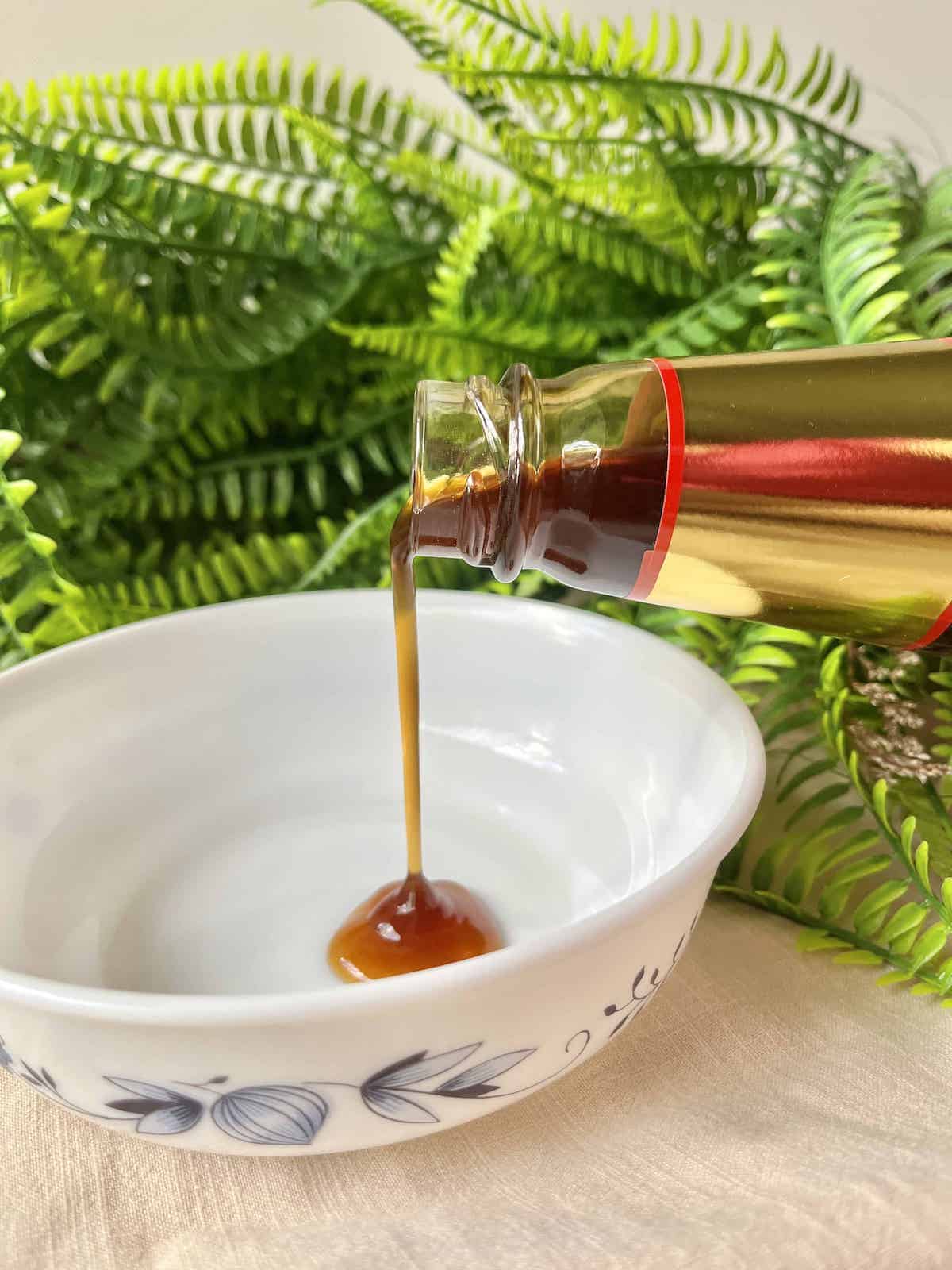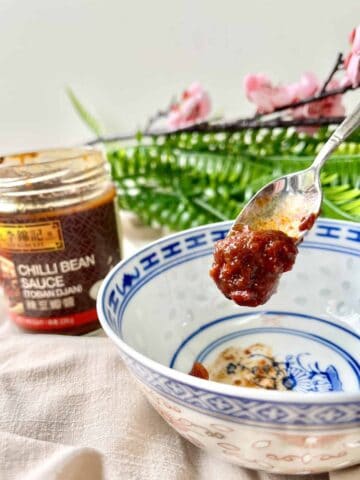The best Oyster Sauce Substitute, and vegan options, in terms of flavor and consistency, when cooking Asian food. I also show you how to DIY your own replacement.

What is Oyster Sauce?
Oyster sauce 蠔油 (Hao You) is a versatile and flavorful ingredient commonly used in Asian cuisine, particularly Chinese dishes, such as this Chinese chicken on a stick. You'll also see it in Thai recipes and Vietnamese food.
It's used for both flavor and to create a glossy look.
You will find it used in stir-fry sauces (e.g. Thai Drunken Noodles), braising liquids (e.g. braised eggs and Lu Rou Fan) as well as marinades. At your Chinese restuarant, it's often swirled onto vegetables before serving.
Slightly less common is adding it to a dipping sauce, such as the dip for Chinese jiaozi.
Note: if you're confused between Hoisin vs Oyster sauce, click through to the article explaining the difference between the 2 Chinese sauces!
History
This iconic Chinese sauce was invented by accident in 1888, when Lee Kum Sheung, the founder of Lee Kum Kee accidentally left a pot of oysters to boil for too long, creating a reduction.
Now, it's too expensive to make it this way, so oyster extract is combined with other ingredients, such as salt, sugar, and thickeners (e.g. corn starch.)
The result is a rich, briny, salty, and umami-packed sauce that plays an essential role in many Asian recipes, from stir-fries to marinades.
Taste
The deep, salty and savory flavor is what sets oyster sauce apart from other ingredients. The seafood flavor is subtle- not as full on as fish sauce- but it's there.
Full of umami, it is a staple in Asian pantries.
Appearance

Oyster sauce typically has a dark brown color. It has a sweet flavor and a thick consistency.
Where to Buy
Oyster Sauce is readily accessible in most supermarkets or online. (If not, go to Asian grocery stores and you'll find it.)
However, if you can't get it or are allergic to seafood, scroll down for the list of the best oyster sauce substitutes, which can help you achieve similar flavors without sacrificing taste or texture.
Note: You can also find vegetarian and gluten-free oyster sauces, usually made of mushrooms.
Brands
There are many brands of oyster sauce.
The 1 I use is Lee Kum Kee (LKK), also the most famous. LKK invented this Chinese condiment in 1888 in Guangdong, China. Most Chinese people choose this brand (unless they're on a budget and decide to choose a cheaper alternative.)
However, LKK oyster sauce contains wheat flour, which may not be suitable for those on a gluten-free diet or have other allergies.
For the best quality oyster sauce, look at the ingredients list. Oyster extract should be the 1st ingredient named (meaning it's used in the largest concentration.) If you see sugar listed before oyster extract, that's not a good sign!
Substitutes
When looking for an alternative to oyster sauce, these are the best options.
Note: Keep in mind that some of these replacement sauces are higher in calories and carbohydrates, so adjust other ingredients accordingly to maintain a balance if necessary.
Abalone Sauce

This is the best substitute for oyster sauce, if you can find it or are not allergic to seafood. (It's harder to get than oyster sauce, outside of Asia. You'll have to go online or to the Asian supermarket.)
Abalone is another type of shellfish, slightly more premium than Oyster, which Chinese people are crazy about, as they think it brings good luck. (Abalone is a key dish during Chinese New Year.)

Abalone Sauce is similar to Oyster sauce, but made with Abalone extract.
1 Tablespoon Abalone Sauce = 1 Tablespoon Oyster
Mushroom Sauce
This is the classic Chinese substitute for oyster sauce.
Both sauces are dark brown thick sauces with umami. Mushroom sauce has a similar consistency and savory, salty flavor to oyster.
Many Chinese Buddhists are vegetarians and thus cannot take oyster sauce. They usually use Chinese mushroom sauce, or vegetarian oyster sauce, to substitute oyster sauce. It is used in vegetarian recipes such as Thai Basil fried rice.
You can find it at Asian markets or online.
Pro Tip: However, mushroom sauce lacks the taste of brine that oyster sauce has. You can mix it with some kelp broth to mimic the flavor of the sea.
1 Tablespoon of Oyster Sauce = 1 Tablespoon of Vegetarian Oyster/ Mushroom Sauce
Hoisin Sauce
Hoisin sauce is a thick, sweet, and savory sauce made from soybeans, sugar, vinegar, and spices such as garlic and chili.
Its Chinese Name translates into Seafood Sauce, but it typically doesn't contain seafood, making it a good substitute for those with seafood allergies.
It is often used in Chinese dishes, such as Braised Chinese Chicken, and is a decent oyster sauce substitute.
However, since hoisin sauce is sweeter than oyster sauce, I suggest mixing with some fish sauce, or light soy sauce if you don't have fish sauce. This both dilutes the sweetness and introduces the briny flavor that hoisin lacks.
To replace 1 Tablespoon of oyster sauce = 0.5 Tablespoon of Hoisin + 0.5 Tablespoon of Fish Sauce/ Light Soy
Fish Sauce
Fish Sauce is much thinner and saltier than oyster sauce but it has the great advantage of bringing a similar briny flavor. It's made by fermenting fish in salt so the smell is strong. Some people find it quite offensive!
If allergic to fish or on a plant-based diet, use vegan fish sauce.
1 Tablespoon of Oyster = 0.5 Tablespoon of Fish Sauce + 0.5 Tablespoon of Sweet Soy/ Dark Soy
Teriyaki Sauce
Teriyaki sauce is a Japanese sauce usually made from light soy sauce, sugar, and mirin (Japanese sweet rice wine). You can make your own or get it from the store.
Its sweet and salty, rich umami flavor means in can be used in place of oyster sauce in some recipes. However, it usually includes alcohol so it is not suitable for some diets.
Teriyaki sauce is sweeter, thinner sometimes lighter in flavor than oyster sauce, so adjust the quantities accordingly. I suggest adding a cornflour slurry to it and simmering over low fire, to thicken it.
1 Tablespoon Oyster = Simmer 3 teaspoons Teriyaki Sauce mixed with cornstarch slurry
Anchovies
These salty small fish are almost as briny as fish sauce. Mash them into a paste, then mix with sweet soy sauce before using as a replacement.
Black Bean Paste
Black bean paste is another popular Cantonese sauce.
It has a unique flavor profile as a vegetarian and vegan oyster sauce replacement. This paste is made from fermented black beans, soy sauce, and vinegar, creating a very strong, tangy flavor.
Black bean paste can be used to replace oyster sauce in various Asian dishes, including stir-fries and noodles. However, the flavor would be very different, so I suggest using this only if you're desperate.
2 Tablespoons of Oyster Sauce = 1 Tablespoon of Black Bean Paste
Homemade

Another popular oyster sauce substitute is to make your own. You can do that by mixing a combination of the following ingredients. However, do note that it will never taste exactly the same as the original, so do this only when you have no choice!
- Fish sauce, light soy, coconut aminos or tamari: fish sauce is a thin sauce made from fermented fish provides a similar umami sea-like taste as oyster sauce. Though it has its own distinct flavor, it can still work well in recipes that call for oyster sauce. If allergic to seafood, use regular soy sauce as a replacement, which is usually vegan and vegetarian friendly. (However, it contains wheat flour, so if you're on a celiac diet, use coconut aminos or tamari instead. Tamari is less salty, so it's good for those on a low sodium diet.)
- Sweet soy sauce: also known as kecap manis, this thick, sweetened version of soy sauce, is popular in Indonesian cooking. It is a suitable vegan and vegetarian option for replacing oyster sauce. It contains Gula Melaka or brown sugar, which provides the sweet taste and can be used in various Asian dishes to add depth of flavor.
- Mushroom broth or kelp broth: mushroom stock is a tasty alternative packed with umami flavor, making it a suitable option for those following dietary restrictions such as vegan, vegetarian, or gluten-free diets. Like mushroom broth, kelp broth has umami but also brings a flavor of the sea. Alone, both are rather tasteless so season well with soy sauce and sugar.
- Worcestershire sauce: this is a more common ingredient in a Western pantry. It is a tangy, savory sauce made from fermented fish, vinegar, and spices. However, note that it is not as good a replacement for traditional oyster sauce as it is much more sour than oyster sauce!
Note: most of these ingredients have a thin and watery consistency, unlike oyster sauce, so you will need to simmer with cornstarch slurry to thicken.
For example, you can mix and simmer:
- Fish sauce + a pinch of sugar + a corn starch slurry
- soy sauce + a bit of sugar + kelp broth + a corn starch slurry
Recipes which Use Oyster Sauce
Frequently Asked Questions
When looking to replace oyster sauce in stir-fry dishes, some people suggest fish sauce or soy sauce. However, both are thinner than oyster sauce and not as sweet. As such, I suggest mixing fish sauce (to provide a similar brininess as oyster sauce) with hoisin sauce (this is thick, like oyster sauce, and provides the sweetness.) If you don't have fish sauce, you can mix light soy sauce and hoisin sauce. Do note the resulting dish will taste a bit different.
Both oyster sauce and teriyaki sauce can be used to add flavor to dishes, with some differences. Firstly, Oyster Sauce is a chinese condiment and Teriyaki is a Japanese sauce. Secondly, the flavor is different. Teriyaki sauce is a sweet, sometimes smoky sauce that is usually made from soy sauce, mirin, sake and sugar. Oyster sauce is thick, sweet and deep sauce with the flavor of the sea. Teriyaki can be used as a great substitute for oyster sauce when glazing food. However, it may not provide the complex flavor as oyster sauce does in certain recipes.
Oyster sauce and soy sauce are both used to add depth of flavor to various Chinese dishes. However, they have some differences. Oyster sauce is made by mixing oyster extract with other ingredients. The resulting sauce has a sweet, umami flavor and a syrupy consistency. Soy sauce, on the other hand, is made by fermenting soybeans and wheat with a brine mixture, which provides a strong umami taste and a thinner consistency. It is thinner lacks the sweetness of oyster sauce. Supermarket-grade soy sauce is typically cheaper than oyster sauce. (Although there are specialty soy sauces that have beennaturally fermented for a longer period of time and cost much more.)
If you have anything to add to this list of the best substitutes for oyster sauce, let me know in the comments!








Comments
No Comments